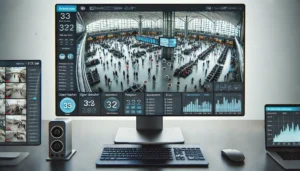In an age where security and ease come together, cloud storage of security cameras is the future. It gives you access to videos at any time, from your own home to your office and can offer scalable storage options as well as security benefits. In this guide, we will take you on a deep dive into security camera cloud storage; what it is, how much it costs, and advanced features.
What is Cloud Storage For Security Cameras?
Security camera storage in the cloud is the method by which security camera recorded video is stored on a remote server accessible through the internet. Instead of using hardware storage like DVR or NVRs, cloud storage is more flexible, stable and secure.
Why Cloud Storage is Great For Security Cameras?
- Reliability: Remote access to your camera footage from any computer, smartphone or tablet at any time helps provide security and ease of mind when observing current activity or capturing archived activities. This is especially helpful for those who travel often or work in several places.
- Scalability: With cloud storage you can easily scale your storage requirements from a few hours of video to a months’ worth of archive. That cuts out the trouble and cost of continuously deploying more data and upgraded physical hardware.
- Better Security: Data can be stored in cloud storage without worrying that it might get lost or damaged or system crash. It offers you a safe platform with the latest encryption and security features such as multi-factor authentication, protecting your data from a breach.
- Easy Integration with Intelligent Cameras: Cloud solutions can easily be integrated with intelligent cameras, which leverage AI to offer advanced facial recognition, motion and activity alerting to build a powerful and easy-to-use platform.
How Security Camera Cloud Storage Works?
When a security camera takes video, the recorded video is either kept locally or uploaded to the cloud using an internet connection. It requires a series of steps to smooth operations:
- Data Recording: Security cameras record video and audio, providing you with all the details of the targeted area in perfect resolution, so you don’t miss a thing.
- Transfer of Data: The video footage is compressed and send to the cloud storage server via encrypted connections, which means it won’t be intercepted or accessed by an attacker.
- Data Archive: The video is stored on the cloud, indexed and easily searched based on time, date, event, etc.
- Data Access: All stored footage can be accessed from the app or web-based interface, providing the ability to view, download, or share individual clips as needed.
What are Cloud Storage Plans for Security Cameras?
Cloud storage plans are made for different purposes and one can select the plan which suits his needs. These are the most typical options:
- Basic Plans: This plan has a shorter period of storage (for example, 7 days of video) and basic features, making it great for a home user or users who do not need much storage and who focus on cost and ease of use.
- Premium Plans: Featuring longer storage periods (like 30 days or more), improved video quality, and added capabilities like AI-driven analytics, these plans are designed for users who need the most functionality like small businesses or tech-savvy homeowners.
- Enterprise Plans: Designed for enterprises, enterprise plans include unlimited storage, support for multiple cameras, and connection to other cutting-edge security systems to provide seamless and comprehensive security management.
Cloud Storage for Security Camera Cost

Cost of cloud storage is variable, based on several variables, such as storage space, time-on-life, and other features. Here is an example of what they generally cost:
- Home Use: Plans range from $3 to $10 per camera per month for basic use and can be a very affordable option for homeowners who need a secure security solution.
- Small Businesses: The plans usually start at $10 to $50 per camera per month and are scalable and feature-rich to let small businesses handle security effectively.
- Business Solutions: Businesses that need large scale surveillance will receive custom pricing per requirements, including volume discounts for multiple cameras, and longer retention times to accommodate legal or business needs.
Additional costs to consider include:
- Costs of bandwidth for frequent or large data transfers — especially for high resolution videos.
- Upgrades available for optional extras such as storing 4K video or adding unlimited storage plans.
if you still keen to find out about how to reduce your security costs we suggest an exceptional article linked here. you can also consider investing in a VMS software, which in the long run will save you a large sum of money, if this intrigues you, check out our article on What is a Video Management System?
Features of Cloud Storage Smart Cameras
Smart cameras with cloud storage combine hardware and software sophistication, making them a critical component for any security setup. Key functionalities include:
- AI-Analytics: These cameras rely on artificial intelligence to pick up unusual behaviors, differentiate between movement of humans and other objects, and significantly reduce false alarms from non-threatening activities.
- Smart Alerts: Users can be alerted on certain events like motion, unauthorized entry, or tampering to respond quickly to security threats.
- Two-Way Communication: With internal microphones and speakers, these cameras can be communicated directly through the app, which can be useful for visiting guests or deterring burglars.
- Smart System App Integration: The cameras can be easily integrated with IoT and smart home systems such as Alexa, Google Assistant or Apple HomeKit to enable greater control and automation.
Comparing Local vs. Cloud Storage for Security Cameras

When considering whether or not to store your security cameras locally or in the cloud, you need to balance the strengths and weaknesses of each solution with your own requirements and situation. Local storage, like a DVR or NVR, stores your footage locally, which might have advantages such as paying less per month and directly managing your data. But that is subject to hardware limitations and vulnerability such as theft or physical damage. Conversely, cloud storage offers unparalleled adaptability and flexibility so that you can view the footage from any place with an internet connection. It provides a scalable solution that eliminates manual effort but usually requires subscription on an ongoing basis. To get you acquainted with these options, here is a very in-depth comparison:
| Feature | Local Storage | Cloud Storage |
| Cost | One-time cost for hardware, which can be affordable initially but may increase with upgrades or repairs over time. | Recurring subscription fees that provide scalable, managed solutions without upfront hardware investment. |
| Scalability | Limited by the physical hardware capacity, requiring upgrades or replacements as storage needs increase. | Virtually unlimited scalability, allowing you to increase storage as your requirements grow. |
| Accessibility | On-site access only, requiring physical presence or a connected local network for viewing footage. | Accessible from anywhere, providing unparalleled convenience and flexibility for remote monitoring. |
| Security | Susceptible to theft, physical damage, or technical malfunctions, risking permanent loss of footage. | Enhanced with encryption and redundancy measures, ensuring data integrity and availability even in unforeseen events. |
| Maintenance | Requires manual updates, repairs, and ongoing attention to maintain functionality and compatibility. | Fully managed by the provider, including updates, backups, and technical support, minimizing user intervention. |
Where to Select the Best Cloud Storage Provider?
When choosing a cloud storage provider for your security cameras, you should consider a few key elements to help you choose a solution that best suits your needs:
1. Storage Time: Decide whether you need footage for a few days or months, so that you do not end up paying for unused storage.
2. Support for High Definition Video: Make sure the service supports high definition video storage, especially if you’re streaming from cameras that are 1080p or 4K-enabled so your footage looks better.
3. Security: Choose vendors that have a robust security protocol, access controls and privacy policies such as GDPR or CCPA.
4. Cost-Effectiveness: Comparing the features and costs of several plans to see which provides the best value without skipping on key functionality or features.
5. Reputation of the Provider: Review the review and downtime of the provider and their customer support to ensure that the company is reliable and can be trusted in the long term.
Security Camera Cloud Storage : What’s in Store For The Future?
1. Edge Computing Integration: Bringing local processing and cloud storage together will free up bandwidth and allow faster, more effective analysis of emergency situations.
2. Artificial Intelligence: As AI advances, more intelligent analytics and predictive monitoring will become the norm to offer proactive security.
3. Blockchain for Security: Blockchain technology will protect the integrity of data, providing impenetrable backups of recorded footage for evidential and regulatory purposes.
4. Green Cloud Services: With the increasing focus on sustainability, service providers will turn to green services, renewable power for data centers, and energy efficient technologies to cut carbon footprints.
Feature Case Studies: Case Study Applications of Cloud Storage for Security Cameras

Example 1: Increasing Home Security for a Reluctant Traveler
Background: Sarah is a businesswoman who travels frequently and needed a safe and accurate solution to keep an eye on her home while she was away.
Solution: She had two cloud-based security cameras mounted over the door and living room. The cameras have motion-detection and AI facial recognition capabilities.
Outcome: Sarah gets real-time notifications on her phone every time someone walks by her door or into her house. The cloud storage allows her to see videos from the past 30 days, so that she never misses out on key events. Being able to watch footage at home allows her to have comfort even when travelling.
Case Study 2: Ensuring Security for a Small Retail Business
Background: A local boutique was plagued with theft and required an efficient, scalable surveillance solution to keep an eye on the store.
Answer: The owner of the boutique set up four smart cameras, connected to a cloud-based storage platform. It offers 24/7 recording, AI activity alerts, and compatibility with third-party POS systems.
Progression: The owner can view video from anywhere, analyze events quickly, even export footage as evidence. Cameras that supported cloud storage helped prevent thefts while the solution’s flexibility meant more cameras could be added when the company grew.
Example 3: Automating Security in a Multi-Site Enterprise
Case: A transportation company that had multiple warehouses required a central security monitoring system to control all sites.
Answer: The organization had deployed 25 cameras at five sites on a cloud-based surveillance system. High-tech options included central monitoring, AI analytics to identify unauthorized use, and 60 days of footage retention.
Results: The centralized platform allowed the security team to check on every site using one dashboard, simplifying operations and avoiding the need for local staff. Viewing footage remotely boosted the company’s response to incidents, resulting in faster resolution times.
Case Study 4: Compliance in Healthcare
Background: A small private clinic wanted a HIPAA compliant security system that could protect patients and staff.
Solution: The clinic migrated to cloud-based cameras, storing footage encrypted, providing multi-factor authentication, and keeping track of usage. Videos were stored for 90 days in compliance with the regulations.
Results: The system was compliant with strong security. People felt more secure, and the clinic could respond to security concerns knowing the footage was safely archived and readily available in the event of an emergency.
Conclusion
Security camera storage in the cloud is changing the way that people and businesses control their security. Flexible plans, greater accessibility, and advanced technologies make it the best choice for convenience and security. With the evolution of technologies, the usage of cloud-based solutions will only rise as part of a contemporary security infrastructure.
Answers to Some Questions About Cloud Storage for Security Cameras.
What happens if my connection is lost?
If you lose your internet connection, many current security cameras will continue to record locally on an SD card or on your computer. When the link is back up, you can download the footage to the cloud. Make sure that your camera is offline-capable for continuous recording.
Is cloud storage secure?
Yes, all reliable cloud providers encrypt your information before transmitting it and after storing it. Security features such as two-factor authentication and regular software updates contribute to the solution as well.
How much cloud storage should I have?
Storage will vary according to the number of cameras, video resolution and the time to store the footage. A 1080p camera, for example, can consume around 50GB for a week of full recording.
Will the cloud work with my current cameras?
Almost all cameras these days can connect to the cloud or be upgraded to use the cloud with a subscription. See your camera’s manual or contact the manufacturer.
Do cloud storage costs extra?
You may have additional charges beyond the subscription for bandwidth, or upgrades for higher video resolution, or even extra features such as AI-based analytics. Review the provider’s terms carefully.
How long can I store video on the cloud?
Storage duration varies by plan. Simple plans can store videos for 7 days and higher or enterprise plans can store up to 30 days or longer depending on your needs.
Do I need to share my video?
Yes, most cloud storage solutions can also securely share video clips through links or downloads, enabling you to hand over evidence to the police or others.
Which Cameras Work Best With Cloud?
The best cameras for the task are IP-connected cameras with cloud connectivity. AI-enabled intelligent cameras also optimize the cloud storage space.






